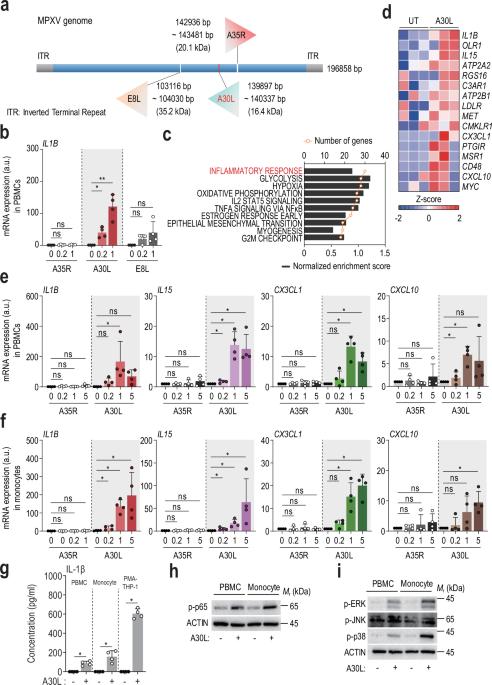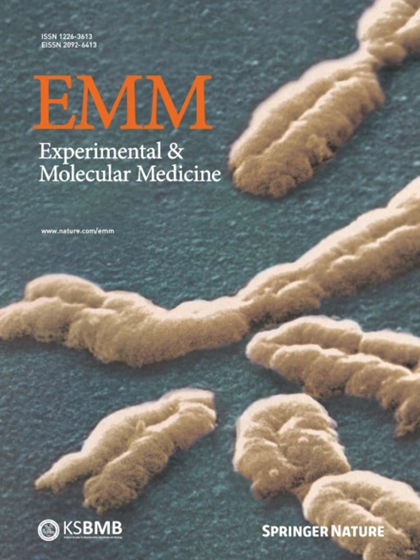The inflammasome-activating poxvirus peptide IAMP29 promotes antimicrobial and anticancer responses
IF 9.5
2区 医学
Q1 BIOCHEMISTRY & MOLECULAR BIOLOGY
引用次数: 0
Abstract
Poxviruses are implicated in a variety of infectious diseases; however, little is known about the molecular mechanisms that underlie the immune response during poxvirus infection. We investigated the function and mechanisms of the monkeypox virus envelope protein (A30L) and its core peptide (IAMP29) during the activation of innate immune responses. The A30L protein and its core peptide, IAMP29 (a 29-amino-acid inflammasome-activating peptide encompassing His40 to Asp69 of A30L), strongly activated the nucleotide-binding oligomerization domain, leucine rich repeat and pyrin domain-containing 3 (NLRP3) inflammasome by inducing the production of mitochondrial reactive oxygen species in human monocytes. Specifically, IAMP29 triggered metabolic reprogramming toward glycolysis and interacted with pyruvate kinase M isoforms (PKM1 and PKM2), thus activating the NLRP3 inflammasome and interleukin (IL)-1β production in human monocytes and murine macrophages. In human primary monocyte-derived macrophages, IAMP29-induced inflammasome activation promoted an antimicrobial response to rapidly growing non-tuberculous mycobacteria. Furthermore, IAMP29 exhibited cytotoxic activity against leukemia cells, which was mediated by pyroptosis and apoptosis. These findings provide insights into the immunological function of the poxvirus envelope peptide and suggest its therapeutic potential. Poxviruses, a group of viruses causing diseases like smallpox and mpox, can manipulate our immune system, but the exact process is not fully understood. This study reveals that a specific poxvirus protein, IAMP29, can stimulate our immune response. It does this by causing NLRP3 inflammasome activation and boosting our body’s defenses against infections and cancer. The research, which involved experiments with human immune cells and mice, found that IAMP29 increases the production of inflammation-causing molecules and strengthens the immune system’s ability to combat fast-growing non-tuberculous mycobacteria (bacteria that do not cause tuberculosis and leprosy) and leukemia cells. The study suggests that IAMP29 could be used as a treatment for these bacterial infections and certain cancers, providing a significant insight into how poxviruses interact with our immune system. This could pave the way for new treatments for infectious diseases and cancer. This summary was initially drafted using artificial intelligence, then revised and fact-checked by the author.

炎症体激活痘病毒肽 IAMP29 可促进抗菌和抗癌反应。
痘病毒与多种传染性疾病有关;然而,人们对痘病毒感染过程中免疫反应的分子机制知之甚少。我们研究了猴痘病毒包膜蛋白(A30L)及其核心肽(IAMP29)在激活先天性免疫反应过程中的功能和机制。A30L蛋白及其核心肽IAMP29(包含A30L的His40至Asp69的29个氨基酸的炎性体激活肽)通过诱导人单核细胞产生线粒体活性氧,强烈激活了核苷酸结合寡聚域、富亮氨酸重复和含吡喃结构域3(NLRP3)炎性体。具体来说,IAMP29 会引发新陈代谢向糖酵解方向重编程,并与丙酮酸激酶 M 同工酶(PKM1 和 PKM2)相互作用,从而激活 NLRP3 炎症小体,并在人类单核细胞和鼠巨噬细胞中产生白细胞介素(IL)-1β。在人类原代单核细胞衍生巨噬细胞中,IAMP29 诱导的炎性体活化促进了对快速生长的非结核分枝杆菌的抗菌反应。此外,IAMP29 还对白血病细胞具有细胞毒性活性,这种活性是由细胞的热解和凋亡介导的。这些发现深入揭示了痘病毒包膜肽的免疫学功能,并提示了其治疗潜力。
本文章由计算机程序翻译,如有差异,请以英文原文为准。
求助全文
约1分钟内获得全文
求助全文
来源期刊

Experimental and Molecular Medicine
医学-生化与分子生物学
CiteScore
19.50
自引率
0.80%
发文量
166
审稿时长
3 months
期刊介绍:
Experimental & Molecular Medicine (EMM) stands as Korea's pioneering biochemistry journal, established in 1964 and rejuvenated in 1996 as an Open Access, fully peer-reviewed international journal. Dedicated to advancing translational research and showcasing recent breakthroughs in the biomedical realm, EMM invites submissions encompassing genetic, molecular, and cellular studies of human physiology and diseases. Emphasizing the correlation between experimental and translational research and enhanced clinical benefits, the journal actively encourages contributions employing specific molecular tools. Welcoming studies that bridge basic discoveries with clinical relevance, alongside articles demonstrating clear in vivo significance and novelty, Experimental & Molecular Medicine proudly serves as an open-access, online-only repository of cutting-edge medical research.
 求助内容:
求助内容: 应助结果提醒方式:
应助结果提醒方式:


